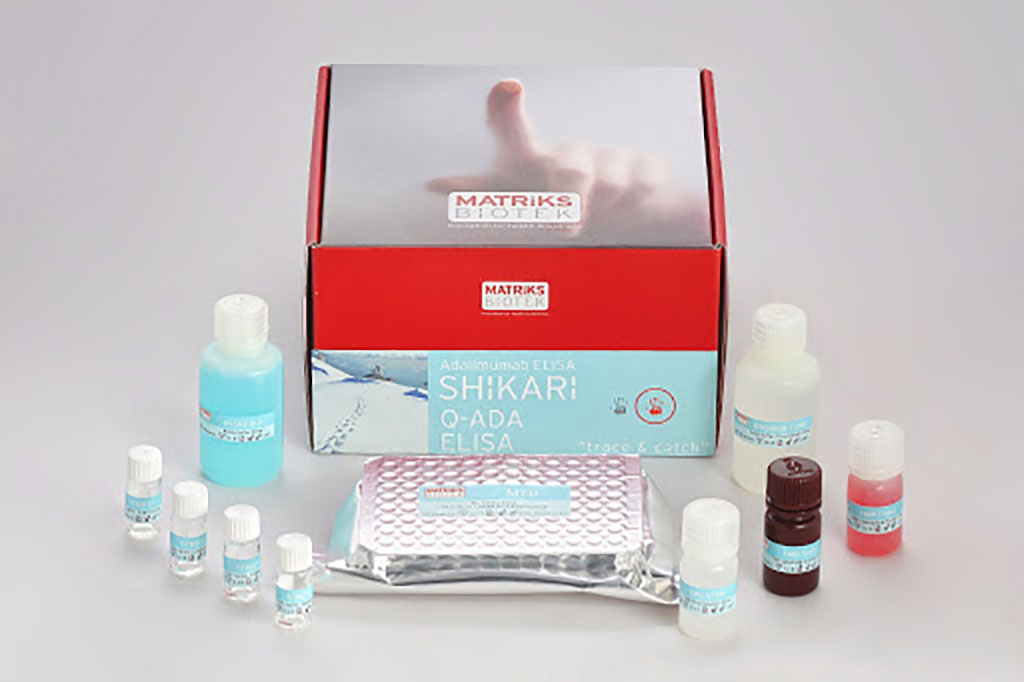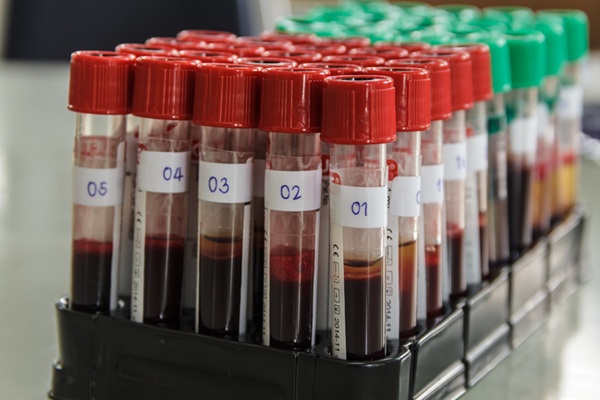Biomarker Predicts Crohn's Disease Relapse in Children
|
By LabMedica International staff writers Posted on 22 Jun 2021 |

Image: Enzyme-linked immunosorbent assay for the determination of anti-drug antibodies (Photo courtesy of Matriks Biotek)
Crohn's disease is a type of inflammatory bowel disease (IBD). It causes inflammation of the digestive tract, which can lead to abdominal pain, severe diarrhea, fatigue, weight loss and malnutrition. Other complications outside the gastrointestinal tract may include anemia, skin rashes, arthritis, inflammation of the eye, and lethargy.
A complete blood count may reveal anemia, which commonly is caused by blood loss leading to iron deficiency or by vitamin B12 deficiency, usually caused by ileal disease impairing vitamin B12 absorption. Rarely autoimmune hemolysis may occur. Ferritin levels help assess if iron deficiency is contributing to the anemia. Erythrocyte sedimentation rate (ESR) and C-reactive protein help assess the degree of inflammation, which is important as ferritin can also be raised in inflammation.
Pediatricians at the Samsung Medical Center (Seoul, Korea) evaluated predictors related to Crohn's disease relapse from anti-tumor necrosis factor (TNF)-α therapy in children, except for calprotectin. From January 2010 to February 2019, 121 children with active Crohn's disease in this study were given TNF-α therapy. Patients were eligible if they were under 18 and received anti-TNF-α therapy for a year. The mean age of patients was approximately 15, and close to 80% were boys. The average observation time was 3.7 years. There were 5% of patients with a previous history of bowel resection surgery. The average Pediatric Crohn’s Disease Activity Index (PCDAI) score was 35 at diagnosis. About 80% of patients received infliximab, with the remainder receiving adalimumab.
Clinical data at the time of one year after anti-TNF-α started were collected retrospectively from electronic charts including the PCDAI score, white blood cell count, hematocrit, platelet count, serum albumin level, serum globulin level, albumin-to-globulin ratio (AGR), erythrocyte sedimentation rate, C-reactive protein, trough levels (TLs) of anti-TNF-α, presence of ADA. Anti-drug antibodies (ADA) were quantified using enzyme-linked immunosorbent assay kits (Matriks Biotek, Ankara, Turkey) at an optical density of 450 nm.
The scientists reported that relapse was observed in 59/121 (48.8%) of patients. The level of calprotectin (odds ratio [OR] = 2.13) and the AGR at one year after anti-TNF-α therapy (OR = 0.0002) were associated with relapse. The AGR at one year after anti-TNF-α therapy was the only factor associated with the time-to-relapse (hazard ratio [HR] = 0.02). The optimal AGR cutoff value for the prediction of relapse was 1.47 (area under the curve, 0.916). The median infliximab trough level (TL) was lower in patients with AGRs <1.47 than in those with AGRs ≥1.47. Anti-drug antibody (ADA) concentrations were negatively correlated with the AGR at one year of anti-TNF-α therapy.
The authors concluded that AGR can be used to predict relapse. Patients with AGRs <1.47 at one year after anti-TNF-α therapy are more likely to have low drug TLs and develop ADAs, which increase the possibility of relapse than those with AGRs ≥1.47. Therefore, if the AGR at one year after anti-TNF-α therapy is less than 1.47, clinicians should monitor disease activity, assess the TLs of the anti-TNF-α agents. The study was published on June 9, 2021 in the journal Gut and Liver.
Related Links:
Samsung Medical Center
Matriks Biotek
A complete blood count may reveal anemia, which commonly is caused by blood loss leading to iron deficiency or by vitamin B12 deficiency, usually caused by ileal disease impairing vitamin B12 absorption. Rarely autoimmune hemolysis may occur. Ferritin levels help assess if iron deficiency is contributing to the anemia. Erythrocyte sedimentation rate (ESR) and C-reactive protein help assess the degree of inflammation, which is important as ferritin can also be raised in inflammation.
Pediatricians at the Samsung Medical Center (Seoul, Korea) evaluated predictors related to Crohn's disease relapse from anti-tumor necrosis factor (TNF)-α therapy in children, except for calprotectin. From January 2010 to February 2019, 121 children with active Crohn's disease in this study were given TNF-α therapy. Patients were eligible if they were under 18 and received anti-TNF-α therapy for a year. The mean age of patients was approximately 15, and close to 80% were boys. The average observation time was 3.7 years. There were 5% of patients with a previous history of bowel resection surgery. The average Pediatric Crohn’s Disease Activity Index (PCDAI) score was 35 at diagnosis. About 80% of patients received infliximab, with the remainder receiving adalimumab.
Clinical data at the time of one year after anti-TNF-α started were collected retrospectively from electronic charts including the PCDAI score, white blood cell count, hematocrit, platelet count, serum albumin level, serum globulin level, albumin-to-globulin ratio (AGR), erythrocyte sedimentation rate, C-reactive protein, trough levels (TLs) of anti-TNF-α, presence of ADA. Anti-drug antibodies (ADA) were quantified using enzyme-linked immunosorbent assay kits (Matriks Biotek, Ankara, Turkey) at an optical density of 450 nm.
The scientists reported that relapse was observed in 59/121 (48.8%) of patients. The level of calprotectin (odds ratio [OR] = 2.13) and the AGR at one year after anti-TNF-α therapy (OR = 0.0002) were associated with relapse. The AGR at one year after anti-TNF-α therapy was the only factor associated with the time-to-relapse (hazard ratio [HR] = 0.02). The optimal AGR cutoff value for the prediction of relapse was 1.47 (area under the curve, 0.916). The median infliximab trough level (TL) was lower in patients with AGRs <1.47 than in those with AGRs ≥1.47. Anti-drug antibody (ADA) concentrations were negatively correlated with the AGR at one year of anti-TNF-α therapy.
The authors concluded that AGR can be used to predict relapse. Patients with AGRs <1.47 at one year after anti-TNF-α therapy are more likely to have low drug TLs and develop ADAs, which increase the possibility of relapse than those with AGRs ≥1.47. Therefore, if the AGR at one year after anti-TNF-α therapy is less than 1.47, clinicians should monitor disease activity, assess the TLs of the anti-TNF-α agents. The study was published on June 9, 2021 in the journal Gut and Liver.
Related Links:
Samsung Medical Center
Matriks Biotek
Latest Immunology News
- Chip Captures Cancer Cells from Blood to Help Select Right Breast Cancer Treatment
- Blood-Based Liquid Biopsy Model Analyzes Immunotherapy Effectiveness
- Signature Genes Predict T-Cell Expansion in Cancer Immunotherapy
- Molecular Microscope Diagnostic System Assesses Lung Transplant Rejection
- Blood Test Tracks Treatment Resistance in High-Grade Serous Ovarian Cancer
- Luminescent Probe Measures Immune Cell Activity in Real Time
- Blood-Based Immune Cell Signatures Could Guide Treatment Decisions for Critically Ill Patients
- Novel Tool Predicts Most Effective Multiple Sclerosis Medication for Patients
- Companion Diagnostic Test for CRC Patients Identifies Eligible Treatment Population
- Novel Tool Uses Deep Learning for Precision Cancer Therapy
- Companion Diagnostic Test Identifies HER2-Ultralow Breast Cancer and Biliary Tract Cancer Patients
- Novel Multiplex Assay Supports Diagnosis of Autoimmune Vasculitis
- Blood Test Predicts Immunotherapy Efficacy in Triple-Negative Breast Cancer
- Simple Genetic Testing Could Predict Treatment Success in Multiple Sclerosis Patients
- Novel Gene Signature Predicts Immunotherapy Response in Advanced Kidney Cancers
- New Technology Deciphers Immune Cell Communication to Predict Immunotherapy Response
Channels
Molecular Diagnostics
view channel
New Biomarker Panel to Improve Heart Failure Diagnosis in Women
Heart failure affects millions worldwide, yet many women are still misdiagnosed or diagnosed too late. Although heart failure broadly means the heart cannot pump enough blood to the body’s cells, its two... Read more
Dual Blood Biomarkers Improve ALS Diagnostic Accuracy
Diagnosing amyotrophic lateral sclerosis (ALS) remains difficult even with advanced imaging and genetic tools, especially when clinicians must distinguish it from other neurodegenerative conditions that... Read moreHematology
view channel
ADLM’s New Coagulation Testing Guidance to Improve Care for Patients on Blood Thinners
Direct oral anticoagulants (DOACs) are one of the most common types of blood thinners. Patients take them to prevent a host of complications that could arise from blood clotting, including stroke, deep... Read more
Viscoelastic Testing Could Improve Treatment of Maternal Hemorrhage
Postpartum hemorrhage, severe bleeding after childbirth, remains one of the leading causes of maternal mortality worldwide, yet many of these deaths are preventable. Standard care can be hindered by delays... Read more
Pioneering Model Measures Radiation Exposure in Blood for Precise Cancer Treatments
Scientists have long focused on protecting organs near tumors during radiotherapy, but blood — a vital, circulating tissue — has largely been excluded from dose calculations. Each blood cell passing through... Read moreImmunology
view channel
Chip Captures Cancer Cells from Blood to Help Select Right Breast Cancer Treatment
Ductal carcinoma in situ (DCIS) accounts for about a quarter of all breast cancer cases and generally carries a good prognosis. This non-invasive form of the disease may or may not become life-threatening.... Read more
Blood-Based Liquid Biopsy Model Analyzes Immunotherapy Effectiveness
Immunotherapy has revolutionized cancer care by harnessing the immune system to fight tumors, yet predicting who will benefit remains a major challenge. Many patients undergo costly and taxing treatment... Read moreMicrobiology
view channel
15-Minute Blood Test Diagnoses Life-Threatening Infections in Children
Distinguishing minor childhood illnesses from potentially life-threatening infections such as sepsis or meningitis remains a major challenge in emergency care. Traditional tests can take hours, leaving... Read more
High-Throughput Enteric Panels Detect Multiple GI Bacterial Infections from Single Stool Swab Sample
Gastrointestinal (GI) infections are among the most common causes of illness worldwide, leading to over 1.7 million deaths annually and placing a heavy burden on healthcare systems. Conventional diagnostic... Read morePathology
view channel
AI Tool Improves Accuracy of Skin Cancer Detection
Diagnosing melanoma accurately in people with darker skin remains a longstanding challenge. Many existing artificial intelligence (AI) tools detect skin cancer more reliably in lighter skin tones, often... Read more
Highly Sensitive Imaging Technique Detects Myelin Damage
Damage to myelin—the insulating layer that helps brain cells function efficiently—is a hallmark of many neurodegenerative diseases, age-related decline, and traumatic injuries. However, studying this damage... Read moreTechnology
view channel
AI Model Achieves Breakthrough Accuracy in Ovarian Cancer Detection
Early diagnosis of ovarian cancer remains one of the toughest challenges in women’s health. Traditional tools such as the Risk of Ovarian Malignancy Algorithm (ROMA) can struggle to distinguish between... Read more
Portable Biosensor Diagnoses Psychiatric Disorders Using Saliva Samples
Early diagnosis of psychiatric disorders such as depression, schizophrenia, and bipolar disorder remains one of medicine’s most pressing challenges. Current diagnostic methods rely heavily on clinical... Read more
Cell-Sorting Device Uses Electromagnetic Levitation to Precisely Direct Cell Movement
Sorting different cell types—such as cancerous versus healthy or live versus dead cells—is a critical task in biology and medicine. However, conventional methods often require labeling, chemical exposure,... Read moreIndustry
view channel
Co-Diagnostics Forms New Business Unit to Develop AI-Powered Diagnostics
Co-Diagnostics, Inc. (Salt Lake City, UT, USA) has formed a new artificial intelligence (AI) business unit to integrate the company's existing and planned AI applications into its Co-Dx Primer Ai platform.... Read more























